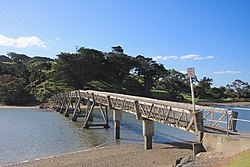|
Pataua
Pataua (Māori: Pātaua) is a settlement in Northland Region, New Zealand. It lies at the mouth of the Pataua River on the Pacific Ocean. Pataua North and Pataua South are separated by a footbridge over the estuary.[3] A community hall is run by the Pataua Outdoor Education and Recreation Trust that is now used mostly for school camps by Primary and Secondary schools from the Whangarei District. It was once a one-room school but the school closed in the 1980s due to low numbers.[4] In recent years a number of the surrounding beef farms have moved towards permaculture, sustainability, and ecotourism.[5][6] It is also a popular surfing destination.[7] The local Pātaua Marae is a meeting ground for the Ngātiwai hapū of Ngāti Kororā.[8][9] DemographicsStatistics New Zealand describes Pataua as a rural settlement. The settlement covers 0.33 km2 (0.13 sq mi)[1] and had an estimated population of 210 as of June 2024,[2] with a population density of 102 people per km2. The settlement is part of the larger Pataua statistical area.
 Pātaua had a population of 165 in the 2023 New Zealand census, a decrease of 12 people (−6.8%) since the 2018 census, and an increase of 39 people (31.0%) since the 2013 census. There were 81 males and 84 females in 66 dwellings.[12] The median age was 53.4 years (compared with 38.1 years nationally). There were 33 people (20.0%) aged under 15 years, 21 (12.7%) aged 15 to 29, 72 (43.6%) aged 30 to 64, and 39 (23.6%) aged 65 or older.[11] People could identify as more than one ethnicity. The results were 87.3% European (Pākehā), 21.8% Māori, 3.6% Pasifika, 1.8% Asian, and 3.6% other, which includes people giving their ethnicity as "New Zealander". English was spoken by 98.2%, Māori language by 5.5%, and other languages by 5.5%. No language could be spoken by 1.8% (e.g. too young to talk). The percentage of people born overseas was 9.1, compared with 28.8% nationally. Religious affiliations were 21.8% Christian, 1.8% Māori religious beliefs, and 1.8% New Age. People who answered that they had no religion were 74.5%, and 1.8% of people did not answer the census question. Of those at least 15 years old, 21 (15.9%) people had a bachelor's or higher degree, 90 (68.2%) had a post-high school certificate or diploma, and 12 (9.1%) people exclusively held high school qualifications. The median income was $41,500, compared with $41,500 nationally. 27 people (20.5%) earned over $100,000 compared to 12.1% nationally. The employment status of those at least 15 was that 63 (47.7%) people were employed full-time and 15 (11.4%) were part-time.[11] Pataua statistical areaPataua statistical area covers 128.71 km2 (49.70 sq mi)[1] and had an estimated population of 1,880 as of June 2024,[13] with a population density of 15 people per km2.
Pātaua had a population of 1,788 in the 2023 New Zealand census, an increase of 204 people (12.9%) since the 2018 census, and an increase of 510 people (39.9%) since the 2013 census. There were 894 males, 885 females and 9 people of other genders in 636 dwellings.[16] 1.8% of people identified as LGBTIQ+. The median age was 45.4 years (compared with 38.1 years nationally). There were 351 people (19.6%) aged under 15 years, 252 (14.1%) aged 15 to 29, 894 (50.0%) aged 30 to 64, and 294 (16.4%) aged 65 or older.[15] People could identify as more than one ethnicity. The results were 87.1% European (Pākehā); 20.0% Māori; 1.3% Pasifika; 2.3% Asian; 0.8% Middle Eastern, Latin American and African New Zealanders (MELAA); and 2.9% other, which includes people giving their ethnicity as "New Zealander". English was spoken by 97.1%, Māori language by 4.5%, Samoan by 0.2%, and other languages by 8.6%. No language could be spoken by 1.8% (e.g. too young to talk). New Zealand Sign Language was known by 0.5%. The percentage of people born overseas was 20.8, compared with 28.8% nationally. Religious affiliations were 20.1% Christian, 0.7% Hindu, 1.7% Māori religious beliefs, 0.3% Buddhist, 0.8% New Age, 0.5% Jewish, and 0.8% other religions. People who answered that they had no religion were 67.1%, and 7.9% of people did not answer the census question. Of those at least 15 years old, 231 (16.1%) people had a bachelor's or higher degree, 804 (55.9%) had a post-high school certificate or diploma, and 300 (20.9%) people exclusively held high school qualifications. The median income was $37,400, compared with $41,500 nationally. 174 people (12.1%) earned over $100,000 compared to 12.1% nationally. The employment status of those at least 15 was that 681 (47.4%) people were employed full-time, 246 (17.1%) were part-time, and 45 (3.1%) were unemployed.[15] References
|
||||||||||||||||||||||||||||||||||||||||||||||||||||||||||||||||||||||||||||

